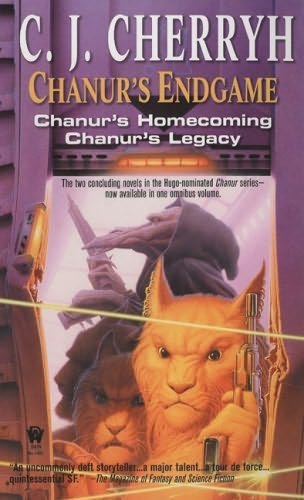So, after the introductory volume and the incredibly tense trilogy, Chanur’s Legacy is a funny bouncy novel about Hilfy Chanur and the stsho. Oh, it has the occasional tense moment, and even the occasional battle, but it’s much more lighthearted than the other books. I sometimes read it on its own, and I sometimes don’t read it when I read the others. I don’t know how well it would stand alone if you hadn’t read the others, but it might be worth trying.
It’s set several years after the end of Chanur’s Homecoming, and Hilfy Chanur, who we first met as juniormost on the Pride, is captain of her own ship. Tully, the lone human of the series, is still on the Pride, and doesn’t appear in this volume except in dreams, making it, unusually, a book without any humans at all. The settings are the same, but there are only two continuing characters, and you don’t find out that one of them even is the same person until the end.
Hilfy is given a mission by the stsho stationmaster of Meetpoint, to take a ceremonial object to Urtur, for a huge fee. Of course it’s more complicated than it seems, especially when she picks up a male hani crewmember. Hallan Meras was the bright-eyed young male last seen in the epilogue to Chanur’s Homecoming. There were several years between Homecoming and Legacy, and I re-read the trilogy several times, so when I discovered Hallan Meras in a Meetpoint jail having conversations with the kif jailors, I was staggered. He was supposed to be our hope of a better future! But he still is, and there’s one way in which this novel can be read as a romantic comedy.
In comments to my last Chanur post, Other Alias said:
I think my favorite thing about it was how the kif transformed from purely evil to simply alien over the course of the series. Once understood, they are not the villains one originally thought them to be.
This is one of the things these books do brilliantly. The various sets of aliens are all quite simple and easy to understand when you first see them, but the more you find out about them the more interesting and complex they are and the more your first impressions seem naive—and all without ever contradicting anything said before. The Pride of Chanur does this with the hani, the trilogy with the kif, and Legacy with the stsho.
The stsho are a vegetarian prey race, the kif call them “grasseaters.” They’re duplicitous, conniving, too close with the methane breathers, the really alien aliens. They’re physically fragile, white-skinned extreme aesthetes who (like humans) need drugs to survive Jump. They have three sexes and Phase under stress to reassemble themselves as another personality. In Legacy we find out a lot more about their physiology and psychology—I can’t really think of any other intelligent aliens developed from herd animals. The Phasing under stress seemed like a cheap evasion in the earlier books, but here we see it as complete personality disintegration and reintegration. Even the white-on-white aesthetics and odd attitude to art comes to make a lot of sense. The part where they panic on the docks when the exploding rock detonates and they all flee in the same direction really rings true, and makes a lot of sense of the double-dealing we have seen in them before.
A lot of the humour of this book comes from Hallan trying his best to do the right thing and messing up. More of it comes from the enormous contract Hilfy signs to take the “preciousness” to Urtur and the long chase it leads them on. There’s the running joke of the exploding rocks, which incidentally opens up the actual economics of trade in the Compact in a fascinating way. I have a very definite picture of the bridge of the Pride, and of Legacy, which is totally based on the wire frame graphics of the ancient computer game Elite. I’d always imagined the trade worked the same kind of way—and it does, but Cherryh has really thought about it and how it could be an actual economy. All too often the economy of space in SF makes no sense at all, so I think Cherryh deserves a lot of credit for thinking about it, making it seem reasonable, and writing about it in a way that’s actually funny. It’s really hard to write about economics and logisticss without being boring.
This is likely to be the last book ever in Compact space. Cherryh’s early books are all set in the Alliance/Union universe, in a timeline that extends in detail from when she started writing them into the very far future. I’m sure this helped her in numerous ways, but it means that with the Chanur books she’d painted herself into a corner—there isn’t any contact with the Compact in books written earlier and set later, and so human contact with the Compact can’t continue, and that makes it hard for her to write more books about them. I hoped for years that she might do a book illuminating the mahendo’sat, or even the methane breathers, but at this point I don’t think she will. She can only really fill in the corners of Alliance/Union, and she has moved on to more open projects. I’m almost reconciled to this, except on days when I’ve just finished Legacy.
Jo Walton is a science fiction and fantasy writer. She’s published eight novels, most recently Half a Crown and Lifelode, and two poetry collections. She reads a lot, and blogs about it here regularly. She comes from Wales but lives in Montreal where the food and books are more varied.










